Don't wanna be here? Send us removal request.
Text
Remote Patient Monitoring App Development – Complete Guide
The next decade will witness an enormous increase in remote patient monitoring services, with a 12.5 percent annual growth rate. Given the aging population, the high expense of in-patient treatment, and the immense demand on hospitals imposed by COVID-19, the trend is entirely foreseeable.
Given the aging population, the high expense of in-patient treatment, and the immense demand on hospitals imposed by COVID-19, the trend is entirely foreseeable.
Healthcare providers are indeed adopting more remote monitoring than ever before. Several hospitals began remotely monitoring the vital signs and symptoms of both coronavirus and non-coronavirus patients to free up beds.
Remote patient monitoring is here to stay, pandemic or not. This article covers RPM in healthcare, how it works, what features it contains, remote patient monitoring benefits and how to begin an RPM program.

What is Remote Patient Monitoring?
Remote patient monitoring, also known as telemonitoring and in-home monitoring, is a combination of technologies and procedures that allow healthcare providers to follow radical improvements in a patient’s health data from a distance and use it in a treatment plan. It is an essential component of the wider telehealth and e-health industries.
The next decade will witness an exponential rise in remote patient monitoring devices, with a 12.5 percent annual growth rate. The trend is inevitable given the aging population, the high expense of in-patient treatment, and the immense demand for hospitals generated by COVID-19.
Healthcare practitioners are already employing more remote patient monitoring tools than ever before. Several hospitals began remotely monitoring the vital signs and symptoms of both coronavirus and non-coronavirus patients to free up beds.
How does Remote patient monitoring improve patient care?
Remote patient monitoring software shines a light on chronic illness patients, post-operative patients, senior citizens, and individuals from remote regions with limited access to healthcare. Recent studies show that remote monitoring can be effective when applied to specific categories.
Rehospitalizations are reduced by 38%.
Cut emergency visits by 25%.
Increase patient satisfaction by 25%.
Lower healthcare expenditures by 17%.
Increase medication compliance by 13%.
Considering the potential benefits of remote patient monitoring, it’s no wonder that over 88 percent of healthcare providers have already invested in or are planning to invest in RPM technology. To achieve their objectives, these technologies must develop an integrated system that spans the complete RPM cycle.
Authorities approved RPM practices. In the United States, the Centers for Medicare and Medicaid Services (CMS) has expanded the list of telehealth services that are eligible for reimbursement. In addition, the US Food and Drug Administration (FDA) has approved using non-invasive hospital equipment in home settings.
Features of Custom Remote patient monitoring
1. Admin Portal
A system administrator is the primary user of the software. He serves as the primary point of contact between the service provider and the service users. The system administrator can onboard users or provider groups and grant the relevant rights and permissions based on the user’s role. He can also handle and oversee all master data and associated papers.
2. User Management
This is the most crucial feature necessary for any admin position to manage all users for whom the application was designed. In this feature, administrators may create users, assign responsibilities to them, and manage all relevant settings.
3. Dashboard
The admin dashboard displays the total number of provider groups linked in the system, total providers, and patients affiliated with various provider groups. The admin may access all information and monitor every activity the provider and patient conducted using the dashboard.
4. Provider Group Management
Provider Group Management allows the administrator to manage a group of physicians. Admin will be in charge of creating, modifying, deleting, or activating/deactivating Provider groups. The admin is required to fill out specific essential fields upon registration. The following fields are included while forming a Provider group:
Provider Group Name
Email Id
Phone Number
Specialty
Physical Address
Shipping Address
Practice Fax Number
Non-Mandatory Information
Uploading a profile picture
Website
5. Patient Management
This function allows the Provider to manage Patients. It allows the Provider to onboard Patients, examine Patient profile attributes, and change Patient onboarding data. Patient management will always have the Patient’s vitals and crucial medical information with the Provider.
It will enable the Provider to follow the vitals of onboarded Patients and monitor and record appointments and notes. The Provider will be required to fill out certain obligatory areas upon registration. The following are the required data that the Provider must fill out throughout the Patient onboarding process.
Patient Name
Address
Contact information
Health conditions
6. Patient Vitals & Alerts
Remote patient monitoring is used for collecting, storing and assessing health information (patient’s vital signs, blood sugar levels, etc.) via live monitoring using devices that transfer information from the home or care facility to a practitioner for vital tracking. learn more
#remotepatientmonitoringsoftwaredevelopment#remotepatientmonitoringAppdevelopment#Remotepatientmonitoringsolutiondevelopmentcompany#Remotepatientmonitoringsoftware#Remotepatientmonitoringsolutions#Healthcare#healthcare interoperability#healthcare solutions#Healthcare Software Development Company
0 notes
Text
EMR software development
Has it been long since you’ve seen a doctor writing you down a paper note? It’s because electronic notes are now widely used in medical facilities. Organizations and healthcare providers often use electronic medical records (EMRs) to maintain vital information about your health and well-being. This guide will explain What EMR is, its benefits and how to develop custom EMR software development.

What is EMR?
EMR is a digital version of a patient’s medical record. An EMR software system allows healthcare facilities to create, store and receive these records.
EMRs contain personal information about the patient, including:
Demographic Information
Vitals
Comment
Drug Information
Lab test results
Immunization records
Allergy Information
In addition to storing and organizing patient medical information, EMR can also be used to:
EMRs do more than just store and organize patient data.
Allow patients to access their medical records via an online patient portal.
Assist providers in prescribing medication.
Used to request lab test results.
Medical bill integration with built-in encryption and billing software.
Difference between EHR and EMR?
The significant difference between EMRs and EHRs is that EHRs are administered by numerous providers, whereas EMRs are solely managed by one. This implies that an EHR has more data than an EMR. Providers primarily use EMRs for diagnosis and treatment.
Another contrast is that EHRs are supposed to be interoperable, but EMRs are not. Interoperability refers to multiple systems’ capability to interchange and uses data among themselves. This is significant because it gives providers access to a patient’s complete medical record, even if they visit many providers. EHRs allow patients’ medical data to be sent locally and globally to specialists, laboratories, imaging facilities, emergency departments and pharmacies.
Key features of Custom EHR/EMR Software
1. Easy Patient Onboarding
Providers can connect with their patients by enrolling them and collecting information such as demographics, contact information, insurance information, clinical data and prior medical and family history. This will result in a strong relationship between the patient and the practitioner.
2. Appointment Scheduling
Providers can effortlessly book appointments with patients and email the patient the customized evaluation form and questionnaire for self-check-in and assessment.
3. Patient Charting- Clinical and E-Prescription
A one-of-a-kind portal that allows patients to view their medical records. It also includes reports from past visits and treatment. Electronic prescribing allows providers to provide digital prescriptions. This feature’s development in electronic medical records software is crucial. This tool allows doctors to notify other team members about medication allergies and other issues.
4. Patient Education
Some health IT providers use natural language processing to translate clinical terminology for individuals with low health literacy, making patient portal records more accessible.
When applicable, patient education is the most effective strategy to enhance consumer health literacy. As more health IT suppliers establish license deals with educational platforms, they will be able to integrate patient education resources into their systems.
5. Reminders, Notifications & Alerts
When a patient schedules an appointment with a healthcare professional, the system can respond through e-mail, text message (SMS) or push notification to a mobile device. Furthermore, users might be reminded to take prescription medicine or check their glucose levels if they have diabetes. Learn more
#EMR systems#EMR software#electronic medical records software#medical record software#healthcare interoperability#Healthcare#healthcare solutions
0 notes
Text
What is Digital Health & its Solutions?
The Covid-19 pandemic changed into a catastrophe that elevated the improvement and implementation of virtual fitness and healthcare information technology (IT) by at least a minimum of 5 years. It has additionally changed Americans’ attitudes toward healthcare providers and patient care. However, the point of interest on Covid-19 obscures three different underlying and interrelated topics to retain to force new applications for digital health and healthcare IT systems.
What is Digital Health?
In simple terms, digital health uses technology and tools to improve the healthcare system. Data science may do wonders using predictive analysis and pattern recognition to identify diseases early and save millions of lives.
Covid-19 boosts digital health in 3-4 months when it might have taken 3-5 years previously. Customers are eager to be a part of the digital transformation in the healthcare revolution. It is now common to use Telemedicine to provide online consultations, ePrescribing, Remote Patient Monitoring, and other similar technological solutions to improve healthcare efficiency. Many major and small companies are moving forward to reinvent healthcare delivery, including Google, Apple, Amazon, GE Healthcare, Siemens, Medtronic, and Philips.

Checkout below “The Digital Health 150” is CB Insights’ annual ranking of the 150 most promising digital health startups in the world.
Benefits of Technology in HealthCare
Digital health offers the ability to prevent illness and reduce healthcare costs while assisting people in monitoring and managing chronic disorders. It may also personalize medication for each patient.
The benefits of digital health also assist healthcare professionals. By considerably boosting access to health data and giving people more significant influence over their health, digital tools provide healthcare practitioners with a comprehensive perspective of patient health. As a result, efficiency has increased, and medical results have improved.
Impact of Digital Health?
Covid-19 forced everyone to use digital products for healthcare Services. 50%-70% population in urban cities book appointments online and take online consultations in most cases. It’s been the most common practice for everyone to order medicine online, thanks to the pharma supply chain. Labs and radiology also came to the party by providing a facility for taking samples at home and providing online reporting systems.
With increasing digital health innovations in medical apps and wearable devices that help individuals calculate calories burned and consumed. These devices and apps motivate one to get off the couch, walk, exercise for a few hours, and burn calories. These tiny little steps from individuals give long-term digital health benefits. Some smart innovations allow one to take pictures and calculate the nutritional value of given food. Now with the help of mhealth, Remote patient monitoring and wearable devices allow us to monitor every aspect of health like weight, exercise, blood pressure, water level, and other health parameters to help us control our health balance.
What are digital health solutions?
There are many healthcare solutions developed by many companies. Please check the list of famous ones.
Telemedicine App
Telemedicine is coined as using digital media and software programs to provide healthcare offerings through the net without healthcare companies needing to be physically present. It has become famous as an alternate method of treating patients without exposing them to covid-19.
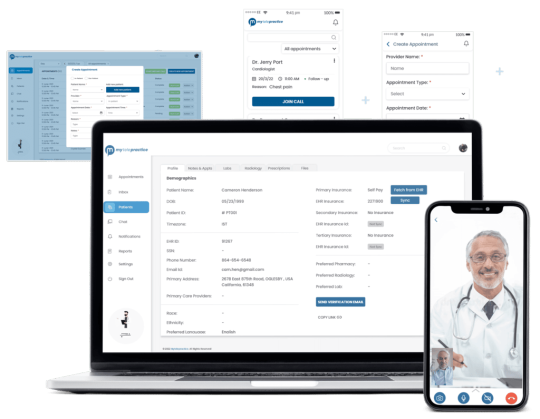
Remote Patient Monitoring
The growing aging of society and the uptick in the variety of chronic diseases necessitate more collaboration among healthcare providers and patients. With the help of remote patient monitoring software, one can monitor all activities and health metrics and provide vital remedies via the internet without personally inspecting them all the time.
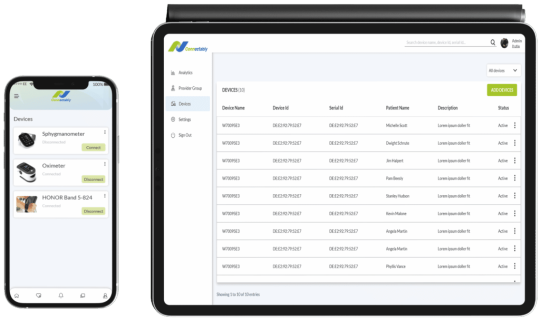
Every healthcare provider aims to run his practice effectively. Practice management software helps providers deliver care effectively. PMS’s essential components are Appointment booking, patient management, Billing and Claims Processing & Reporting.
Chronic Care Management
Chronic Care Management solution allows providers to onboard patients with 2 or 3 chronic conditions. CCM solution allows providers to create care plans with actionable items to be done by patients. Application tack every minute the provider spends to create a claim at the end of the month.
Revenue Cycle Management
Revenue cycle Management enables providers to manage their financial workflows associated with patient medical billing and Invoicing, Insurance verification with authorization and eligibility checking, claim processing and follow-up, denial & rejection handling, payment collection and AR follow-up, Electronic remittance and explanation of Benefits posting.
EMR/EHR Software
EMR system is software that privileged hospitals to deal with patient clinical data. The EMR is a digital chart that a healthcare practice or organization uses to maintain a patient record. It eliminates the older paper chart and can often communicate with a pharmacy. Learn More
#digital health#benefits of digital health#digital health technology#interoperability in healthcare#EHR integration#Role of AI in Healthcare#Role of IoT in Healthcare
0 notes
Text
What is Web Scraping?
Imagine a process where you want to acquire data from any resource or website. The first thing that a developer thinks of does the source has a developer account and it provides an API to get the required information, but in the majority of cases, there are no dev accounts and no APIs available, which makes it difficult to acquire information. Here web scraping comes to the rescue. In web scraping, we analyze the HTML of a website and write the data extraction logic programmatically and store the information in either DB or export the data as a spreadsheet or send the data as a part of the API
Tools & Technologies used for web scraping
Python language used for web scraping. In Python, we have the Scrappy framework and a library called BeautifulSoup widely used to get solutions for web scraping. Selenium acts as a mode to mimic browsers in case we need to provide user credentials to log in to any website/application, or it is used in cases where the data is loaded only when we scroll to the bottom and extract data. Using Selenium, we can provide click events and mouse movements that mimic the user accessing the website or application.
Step-by-step process of Web scraping
The first step will be to Identify the target website from where we want to extract the data in the case. I have chosen Flipkart to scrape the reviews of any product.
Then we need to collect the URLs of the pages which you want to extract data from.
Now we need to make a request to these URLs to get the HTML of the page to make the request. We can use the requests library in python.
After this, you will have the HTML page of the URLs as text then. We need to use the Beautiful soup library, with the help of which we can easily track the location of the desired data and extract(scrape) only that data out of the HTML.
Now we can save the data in a JSON, CSV file, or another structured format.
Challenges in Web Scraping
A- Although it is easy to scrape the data for small projects. There are some challenges in most cases, such as tackling the change in the layout of the webpage, which means if the layout of the webpage changes, the logic we have implemented to get the structured data should also be changed accordingly.
B- Since web scraping requires a lot of requests made to a server from an IP address. The server may detect too many requests and block the IP address to stop further scraping. Proxies rotate the IP address, which helps to avoid blocking the scraper and any issues. It also helps hide the machine’s IP address as it creates anonymity.
C- Most websites use CAPTCHA to detect bot traffic. By using CAPTCHA-solving services, we can bypass this extra layer. There are a few CAPTCHA-solving services:
Anti Captcha
DeathByCaptcha
Implementing Web Scraping in Python with BeautifulSoup
So here we will see the implementation of building a simple web app using flask to scrape the reviews of the products listed on the Flipkart webpage:
Here the first steps will be to install and import all the required libraries:

After successfully importing the required libraries, we will write the steps to fetch the reviews in the structured format; below code is to fetch the reviews section data; we just have to pass the product name in the search string from the frontend:

To select the class of any object on the HTML, you have to go to the HTML page and right-click on the page anywhere, like the below snapshot:

And click on the inspect option; after this, a dev page will open you just have to hover the mouse over the object to see the class of that object on the dev page; below is the example snapshot attached:

So as you can see, by hovering over the review, it is showing “_16PBlm” as the class name. So I have taken that as the class name in the code.
In the above code.. learn more
#artificialintelligence#datamining#datascience#datascraping#python#pythonprogramming#webcrawling#webscraper#webscraping#webscrapping
0 notes
Text
What is Kubernetes?
Definition:
Kubernetes (also known as k8s or “Kube”) is an open-source containerized applications management platform that helps DevOps automate many manual processes such as deploying, managing, and scaling containerized applications.
In layman’s terms:
Kubernetes is a system that manages containers (containerized applications) where a container is a built image of an application that holds all the required things to run that application(like platform info., dependencies, libraries, environment variables, etc.) Building a complete application requires many services and so do the containers. Managing those containers is a hectic and time-consuming job for a human. To minimize the efforts and time required, Kubernetes comes into play.
Why Kubernetes?
Containerized applications deployed in K8s start up faster than the virtual machines we deploy. Kubernetes is 53% faster in deploying applications than other tools, which significantly impacts the life of DevOps.
It also makes scaling an application easier because of less time consumption.
The auto-scaling capability of Kubernetes is a huge advantage as new business requirements need something which can auto-scale up and down on its own to save the cost required to run applications.
Great!
Let’s first understand the components of K8s:
Control plane: The collection of processes that control Kubernetes nodes. It is responsible for task assignments in the K8s cluster.
Nodes: A node is a machine that performs the task requested by the control plane, which includes deploying pods, assigning resources, etc. A node can hold one or more pods.
Pod: A pod is a group of one or more containers that are deployed on some node on the K8s cluster. All containers in one pod share an IP address, IPC, hostname and resources. It is easy to move Pods through the cluster because they abstract network and storage from the underlying containers.
Replication controller: This is responsible for creating copies of the pod and managing the number of replicated copies on the cluster.
Service: Services manage the incoming and outgoing from Pods. No matter where the Pod is on the cluster or if it is replaced, the service will always proxies the request to the right Pod.
Kubelet: This service runs on nodes and reads from container manifests. It manages the defined containers and their state, ensuring they are started and running.
kubectl: It is a command line configuration tool for K8s. With the help of kubectl we can get all the information about the K8s cluster and deploy it onto the cluster with simple commands.
Hmm….. But how should it be done?
Let’s look at the basic overview of what we are gonna cover in this Chapter

Let’s Start by creating a docker image –
Prerequisite:
Backend Code in running state
Docker installed on the local machine
ECR registry
Kubectl installed on the local machine
Create a “Dockerfile” without any extension in the root folder of your project
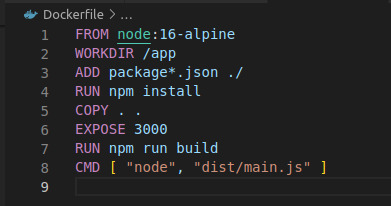
In the above code, we have exposed Port 3000. It is the port on which our application is going to listen. And the last line holds the command to run your application.
To create an image, use the following command-
docker build -t image_name.
Now the image is ready and we have to push this image to our ECR repository-
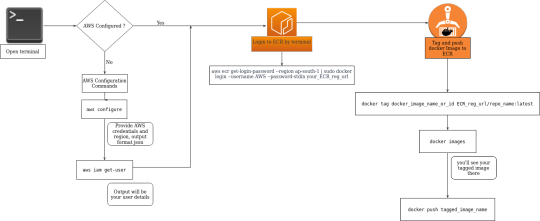
To access our AWS account on the local terminal, we have to configure it first. To configure, use the following commands-
AWS configure
AWS iam get-user

After the first command, provide AWS credentials and output format as “JSON.” The second command will show you the user you just have configured... learn more
0 notes
Text
Telemedicine App Development: Features, Process and Cost
Telemedicine is no longer a buzzword in the medical field. The telemedicine industry was thriving even before the covid pandemic. The telemedicine market is projected to grow at a CAGR of 22.67% and reach 175.5 billion USD by 2026.
With healthcare organizations of all sizes evolving with the trends and adopting telemedicine, there is now a boom in telemedicine app development.
Developing a telemedicine app can be a game-changer for healthcare organizations and providers. Telemedicine services can eliminate healthcare providers’ difficulties, providing better healthcare facilities.
This article will cover everything you need to know to develop custom telemedicine software.

What is Telemedicine?
Telemedicine is a service that enables you to speak with a specialist remotely. A doctor’s appointment can be held through video or phone.
Instead of a conventional approach, you can use a telemedicine app on your mobile device to watch patient schedules.
We are living in unusual times. Although telemedicine was a good idea ten years ago, it is now essential for hospitals and healthcare providers.
Because of the availability of advanced technology, the shift has been flawless. Telemedicine applications are becoming an increasingly important part of our daily life.
Telemedicine vs. telehealth
Although “telehealth” and “telemedicine” are sometimes used synonymously, they have significant distinct characteristics.
A more general word is “telehealth.” It is described as the use of technology in all aspects of healthcare. Electronic portals for transmitting or storing medical records may fall under this category. It may also have tools for remotely tracking essential metrics.
Following are some examples of telehealth app activities:
Patients use a mobile app to monitor their cholesterol levels and blood pressure.
They can access their lap reports, schedule appointments, and buy prescribed medicine via a patient portal.
They would also be able to get online reminders for medication renewals, vaccines, or medical checks.
One subset of telehealth is telemedicine. You can access your doctor’s clinical services using information or communication technology. Telemedicine aims to provide treatment and, ideally, enhance health outcomes.
In other words, telemedicine is applying technology to avoid routine in-person visits while achieving clinical outcomes.
Following are some examples of Telemedicine activities:
An X-Ray scan report is transferred through the internet, and the provider is notified.
Consult a dermatologist through video chat if you have an uncommon skin rash or pigmentation.
What are the Benefits of Telemedicine apps?
Telemedicine technologies have aided in the detection, diagnosis, management, therapy, and long-term monitoring of various chronic conditions. It provides several advantages to healthcare providers and patients, aiming to improve clinical outcomes.
Minimal Pathogen Exposure: No in-person interaction between HCPs and patients. As a result, the likelihood of contracting a disease from pathogens decreases.
Midnight Care: Telemedicine consultation provides medical services from remote locations in real time and is available to patients anytime.
Assist doctor: During the most recent pandemic and lockdown, online consultation and chat between a patient and a provider worked efficiently.
Chronic disease patient: Telemedicine is a handy choice for chronic disease patients since it allows them to avoid making actual hospital visits.
Online Psychiatric Support: Physicians provide several benefits to psychiatric patients. Personalized treatment and speedy recovery are two examples.
Features of Telemedicine
Standard telemedicine software often includes three independent but parallel components: a provider dashboard, a patient dashboard, and an admin dashboard. Here are the top telemedicine app features you should try to implement when developing a telehealth app.
Easy Patient Onboarding
Patients can schedule an appointment with the doctor of their choice after completing an easy and quick registration process. Instead of typing, patients can submit their medical data, insurance verification information, and past prescriptions before getting treatment from specialists.
Patient Management
Before giving treatment, providers can create patient profiles by gathering personal data, such as name, age, gender, medical history, prescription notes from prior visits, and other pertinent information. All patient profiles are directly accessible to the Provider, who may also remove, update, and review vitals and financial history.
Appointment Booking and Scheduling
Patients can browse doctor profiles and use a calendar to arrange an appointment with a provider. Doctors should be able to accept consultation requests, set their schedules, confirm appointment requests, and manage their appointments.
Video Consultation
Let providers teleconference with patients in real-time through video and voice calls. Teleconferencing should be seamless and high-quality so physicians can check patients remotely to identify illness signs and symptoms.
Instant Messaging and Chat
Extra features in the provider’s app include a personalized dashboard with in-built secure chats and messaging in any case.
To learn more about Telemedicine App Development click here
#telemedicine#app development#app developing company#Healthcare#healthcare software development company#CustomSoftwareDevelopmentCompany#Healthcare interoperability
0 notes
Text
Microservices Architecture with Spring Cloud
What are microservices?
Microservices is an architecture(service-oriented architecture) (SOA). In this architecture, applications are broken down into various services. The motivation behind this is separation and modularity.
Monolithic architecture and microservices are more beneficial.
We don’t need to specify all business logic into a single software module. It leads to complexity and time-consuming debugging.
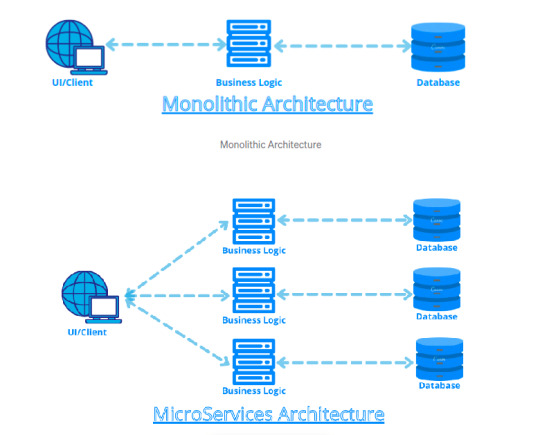
In the above diagram, as we can see, we have only one unit of application in a monolithic architecture. In a microservices architecture, we can see three different services.
Advantages
Increases scalability
More flexibility
Modular architecture
Ease of introducing new features
More reliable and robust structure
Challenges
Cost management
Network latency and load balancing
Complexity at the end-to-end testing
Health Care Example
Let’s take an example
Spring Cloud
It helps us build microservices architecture with various components it provides. Spring cloud helps us manage communication, security threats, maintenance and fault tolerance with different components. Let’s see them one by one.
Spring Cloud Components
Spring Cloud Config Server
Feign Client
Service Discovery and Registry with Eureka
Spring Cloud Gateway
Resillience4j
Spring Cloud Bus
Spring Cloud -> Config Server
Config server uses the git repo to store configurations.
Ease of managing configuration of multiple microservices in a single place
Configurations can be managed with the application.yaml / properties files within a git repo
Each microservice can connect to the config server and get the required configurations
Spring Cloud -> Feign Client
Microservices need to communicate with each other to exchange information. Feign client can be used for that learn more
#microservices#cloud blogs#spring#Healthcare#healthcare software development company#Healthcare interoperability#healthcare solutions
0 notes
Text
Docker: How to get a Node.js application into a Docker Container
Introduction
The goal of this article is to show you an example of dockerizing a Node js application. Where you can have a basic understanding of Docker. It will help you to set up the Node js application and docker installation.
What is Docker?
Docker is an open-source platform for developing, shipping, and running applications. Docker enables you to separate your applications from your infrastructure so you can deliver software quickly. With Docker, you can manage your infrastructure in the same ways you manage your applications. By taking advantage of Docker’s methodologies for shipping, testing, and deploying code quickly, you can significantly reduce the delay between writing code and running it in production.
Why Docker?
Developing apps today requires so much more than writing code. Multiple languages, frameworks, architectures, and discontinuous interfaces between tools for each lifecycle stage create enormous complexity. Docker simplifies and accelerates your workflow while giving developers the freedom to innovate with their choice of tools. The day which comes in every developer’s life that application is working on our system, but It’s not working on the client’s system. To prevent this type of situation, we use Docker.
How can we use Docker with Nodejs?
Before starting, I am assuming that you have a working Docker installation and a basic understanding of how a Node.js application is structured.
In the first part of this video, we will create a simple web application in Node.js, then we will build a Docker image for that application, and lastly, we will instantiate a container from that image.
Setup Nodejs Server
Run command npm init and add the required details for your project
Install express in the project using npm I express
Then, create a server.js file that defines a web app using the Express.js framework:
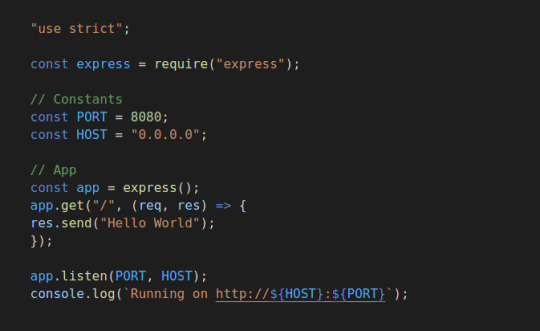
Now we can test the node server, and start the application using node server.js. Let’s try to hit the URL http://localhost:8080/ and check the response

In the next steps, we’ll look at how you can run this app inside a Docker container using the official Docker image. First, you’ll need to create a docker file, Where we are going to add some commands.
#Dockerfile
Create a docker file in the root directory of the project using the touch command.

Edit the docker file using any editor and write the below instructions into the docker file.

Initially, we need to pick a node image that will run on a container, and here I am using the latest stable version of the node.

Next, we need to create a directory for the application. Here we can add all the project files.

This image comes with Node.js and NPM already installed, so the next thing we need to do is install your app dependencies using the npm install. So I am going to copy the package. JSON file.

To bundle your app’s source code inside the Docker image, use the COPY instruction:

Your app binds to port 8080 so you’ll use the EXPOSE instruction to have it mapped by the docker daemon:

Lastly, we are going to run the application using the CMD, which will execute node server.js
To see the final outputs please click here
0 notes
Text
Custom Software Development
What is custom software development?
It is precisely as it sounds!
Custom software solutions are distinctive and assist in meeting specific requirements at a reasonable cost.
Nowadays, tech companies require software for a variety of purposes. Custom software assists organizations in fulfilling and executing all of their business processes smoothly with multiple functionalities.
As we know that every business has its specific and unique needs, and the only way to meet them is through custom solutions.
The industries like Healthcare, Real Estate, Manufacturing, Retail, E-commerce, etc. have created standards that lead to customization in their solutions.
Let’s consider the ways of developing ERP for Retail and Healthcare. Retail business needs Inventory management, warehouse management, order management and CRM in their ERP system. ERP for Healthcare industries includes Patient Management, Hospital Ward Management, Nursing Management, Laboratory Management, Electronic Medical records, EHR Integrations, LAB Integration, Appointment Scheduling & Booking, Patient Portal, Video Chat & Secure Messaging etc.
It indicates that these industries have different workflows and requirements, which directs to the development of Custom Software Solutions.

What are the benefits of custom software development?
Many organizations want to build unique Custom solutions to deliver to their customers. Custom software solutions only focus on their needs.
If you have a confusion about building Custom software solutions or any other software, you must go with the benefits of Custom software.
There are a few good benefits to using Custom software solutions rather than Generic software solutions. Here’s a quick overview:
Generic Software Development
Custom Software Development
Used for developing a general-purpose software
Use to develop a software product as per the needs of a particular business
It is not too easy from designing and marketing perspective
For an appropriate group of users, Custom Software has been developed
In Generic software, the quality of the product is not a preference
In Custom Software Product, quality & functionality is the main criteria & preference
Generally, there may be some hidden costs, such as installation and implementation cost
The software product is costly as the particular product for the customer is developed
Challenges of developing custom software?
It has always been challenging for Custom Software solutions to meet the requirements of businesses.
Below are the critical challenges of developing custom software:
1. Inadequate Software Development Planning:
To be precise, this is one of the most severe challenges as they take the first step in development. The most crucial thing in Custom software development is gathering & understanding a customer’s requirements & perspectives.
To evaluate this, every team should stick to the plan as every project needs appropriate development in the building phase. So a clear plan and pre-defined solutions must be needed to be successful.
2. Changeable requirements:
Sometimes customers’ minds frequently change and want to switch the entire requirement, code, or project-related problems in the middle phase of the building.
The customer wants some additional features or wants to change technology in the middle phase of the project. It may create an issue for business owners to acquire those changes quickly.
3. Technology Stack Issues:
The Standard of technology matters a lot!
We must consider whether the requirement is settled or approved and documented after considering the above two factors. Right?? But there may be another scenario.
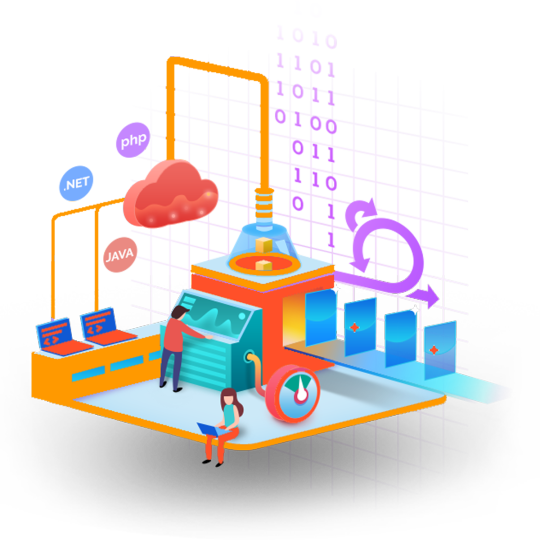
Technology is continuously changing in the market, so the technical team needs to check for technical challenges and they should be upgraded with a new tech stack.
Technology is often incompatible with the external environment and platforms, so we have to manage different variants in such situations.
4. Inefficient Project Management:
One of the biggest reasons behind the unsuccessful project delivery is inappropriate project management planning.

Below are a few reasons:
- Choosing the incorrect technology stack
- Select inappropriate tools
- Assign the wrong tasks to the wrong team
- Consume more time on simple tasks & vice versa
- Recognize the risk of the project at the right time
- Find the right solution to escape the risk
- Make sure all team members are on the same page
- Coordination & communication between team members
- Look over the growth & progress of the project
- Incorrect resource & time management
To learn more about Complete guide: Custom software development in Healthcare industries click here
#customsoftwaredevelopment#CustomSoftwareDevelopmentCompany#Customsoftwaredeveloper#top custom software development companies#custom software development companies#hiresoftwaredevelopers#healthcare software development company#Healthcare interoperability
0 notes
Text
Blockchain: A simplified understanding of Hash, Block, Blockchain & Distributed Blockchain
A blockchain can define as a constantly growing ledger that keeps a permanent record of all the transactions. That has taken place in a secure, chronological, and immutable way.

That information is kept in a very secure manner because there are thousands of copies of identical blockchains worldwide. To know more about the blockchain and it's components check our blog
#blockchain#bitcoin#blockchain development#customsoftwaredevelopment#hiresoftwaredevelopers#blockchain developer roadmap
0 notes
Text
GitFlow: A tool to simplify a project’s workflow, collaboration & SCM in Git
GitFlow is a tool (or can be said to be an extension of Git) that provides an adequately structured workflow for better source code management. Since GitFlow is a tool, we need to install it, after which we can start using it. To know more about Gitflow and how it simplify a project's workflow, collaboration & SCM in Git check our blog

#gitflow#customsoftwaredevelopment#Healthcare#healthcare software development company#Healthcare interoperability
0 notes
Text
Mirth Connect and its application as HL7 Parser
HL7 is a collection of international standards for data transfer and sharing among healthcare providers. In particular, HL7 bridges the gap between health IT applications and makes sharing healthcare data more accessible and efficient than previous approaches.

To learn more about Mirth Connect and its use as an HL7 Parser. Check out our blog
0 notes
Text
Color Psychology & Color Theory Guide for UI Design
Color Psychology reveals that colors have a huge and vast impact on the human mind and conduct. We may not know, but human minds react to colors unconsciously and we humans don’t even realize that. Whenever human eyes glimpse a color, it connects with the human brain. Then the human brain sends signals to the endocrine system, which then releases hormones according to the impact of that color.

Success of a project is mainly determined while selecting the color palette as 62% to 85% of success depends only on the color itself. To know more about Color Psychology and color theory in UI Design check our blog
1 note
·
View note
Text
Healthcare Interoperability: Challenges and Solutions
Digital technology has allowed providers to offer quality healthcare. As the number of solutions and tools increases, there are many touch points where data is generated and It became necessary to get all patient health information in one place to make better decisions.

Healthcare interoperability enables you to access and exchange medical information across different healthcare applications and devices. Let's understand what Healthcare interoperability is and how Thinkitive has come forward with multiple technological solutions to help providers to make their job easy👇 You can check out our Healthcare interoperability Blog here : https://bit.ly/3hyx1F3
#healthcare software development company#software development company#offshore software development company#Healthcare interoperability#What is healthcare interoperability
0 notes
Photo

#Thinkitive is hiring for Administrative Assistant profile Experience - Freshers to 6 Months Hurry up & Apply! Great opportunity for career progression in a fast-paced environment! Our growing company is in need of a resourceful Administrative Assistant to support the Human Resource & Finance Department for smoothing Operational activities! If you are #interested then apply for the job by sharing updated CV on a below-mentioned mail id, also share the post with your #connections [email protected] #hiring #hiringincovid19 #recruitment #jobalert #jobopportunity #job #thinkitive #workwithus #5daysworking #hiringalert #Admin #naukri #thinkitivesuper6 #jobseekers #jobs #quarantine #customsoftwaredeveloper #covidjobs #hr #hiredevelopers #Administrativeassistant #finace #Humanresource #jobsearch #nowhiring #hiringtalent #jobseeking (at Thinkitive Technologies) https://www.instagram.com/p/CGFGabShxag/?igshid=13qxj79ajvp1w
#thinkitive#interested#connections#hiring#hiringincovid19#recruitment#jobalert#jobopportunity#job#workwithus#5daysworking#hiringalert#admin#naukri#thinkitivesuper6#jobseekers#jobs#quarantine#customsoftwaredeveloper#covidjobs#hr#hiredevelopers#administrativeassistant#finace#humanresource#jobsearch#nowhiring#hiringtalent#jobseeking
0 notes
Video
🎨 Do You or Your Organization Follow The Design Thinking Approach? #Super6 - Follow @thinkitivetech - Video belongs to respective 📌 owner! 🤠 - #success #thinkitivesuper6 #2K20 #Completing6years #successtory #thinkitive #hiresoftwaredevelopers #customsoftwaredevelopment #team #efforts #ux #uxdesign #uxdesigner #userexperience #uxresearch #designer #uxuidesign #wednesdayTips #wednesdaymotivational #Designguide #Uidesign #userinterface #designprocess #approach (at Thinkitive Technologies) https://www.instagram.com/p/CGCjpikBfhq/?igshid=1b3nxc5zx8auu
#super6#success#thinkitivesuper6#2k20#completing6years#successtory#thinkitive#hiresoftwaredevelopers#customsoftwaredevelopment#team#efforts#ux#uxdesign#uxdesigner#userexperience#uxresearch#designer#uxuidesign#wednesdaytips#wednesdaymotivational#designguide#uidesign#userinterface#designprocess#approach
0 notes
Video
💡 What We Do At #Thinkitive #Super6 - Follow @thinkitivetech - Video belongs to respective 📌 owner! 🤠 - #success #thinkitivesuper6 #2K20 #Completing6years #successtory #Comingsoon #journey #memoriesforlife #rememberingmemories #corevalues #Newoffice #hiresoftwaredevelopers #customsoftwaredevelopment #team #efforts (at Thinkitive Technologies) https://www.instagram.com/p/CFrVbxYh0FB/?igshid=no5gux40b537
#thinkitive#super6#success#thinkitivesuper6#2k20#completing6years#successtory#comingsoon#journey#memoriesforlife#rememberingmemories#corevalues#newoffice#hiresoftwaredevelopers#customsoftwaredevelopment#team#efforts
0 notes